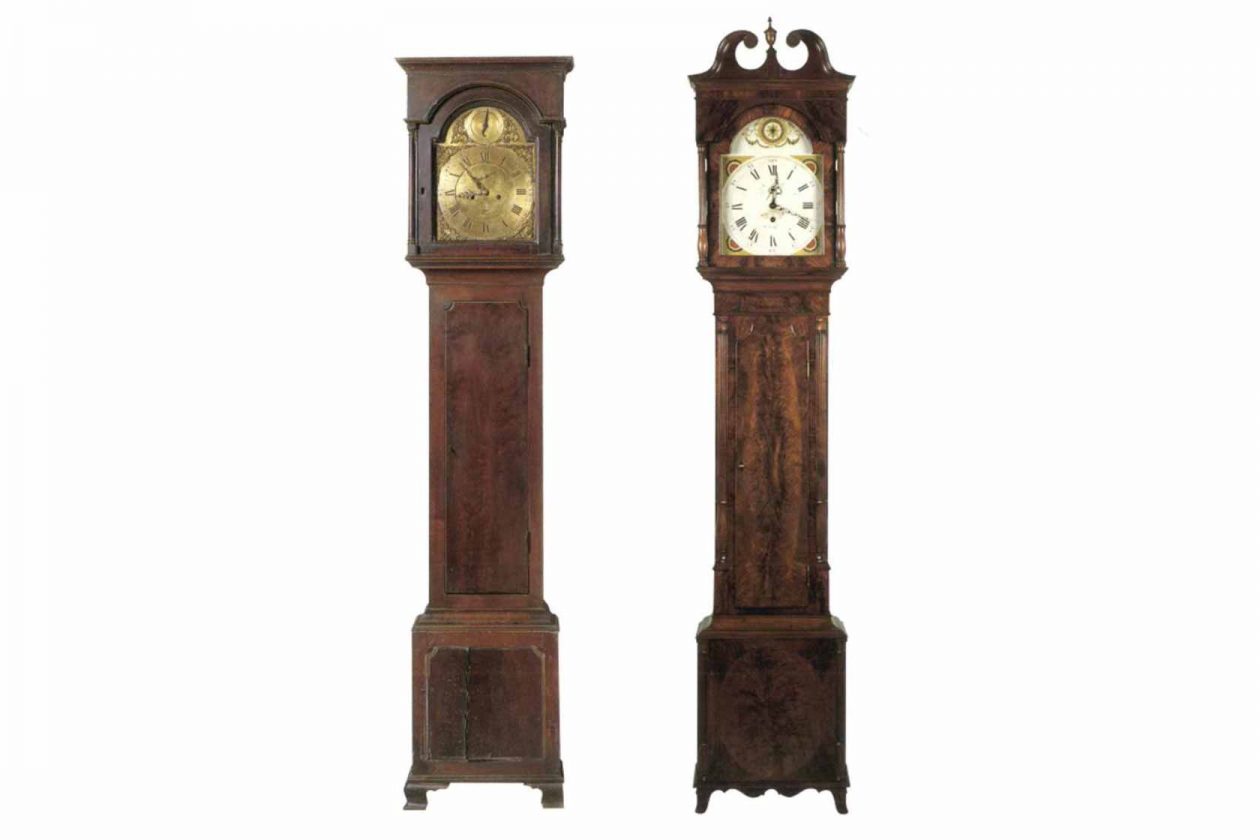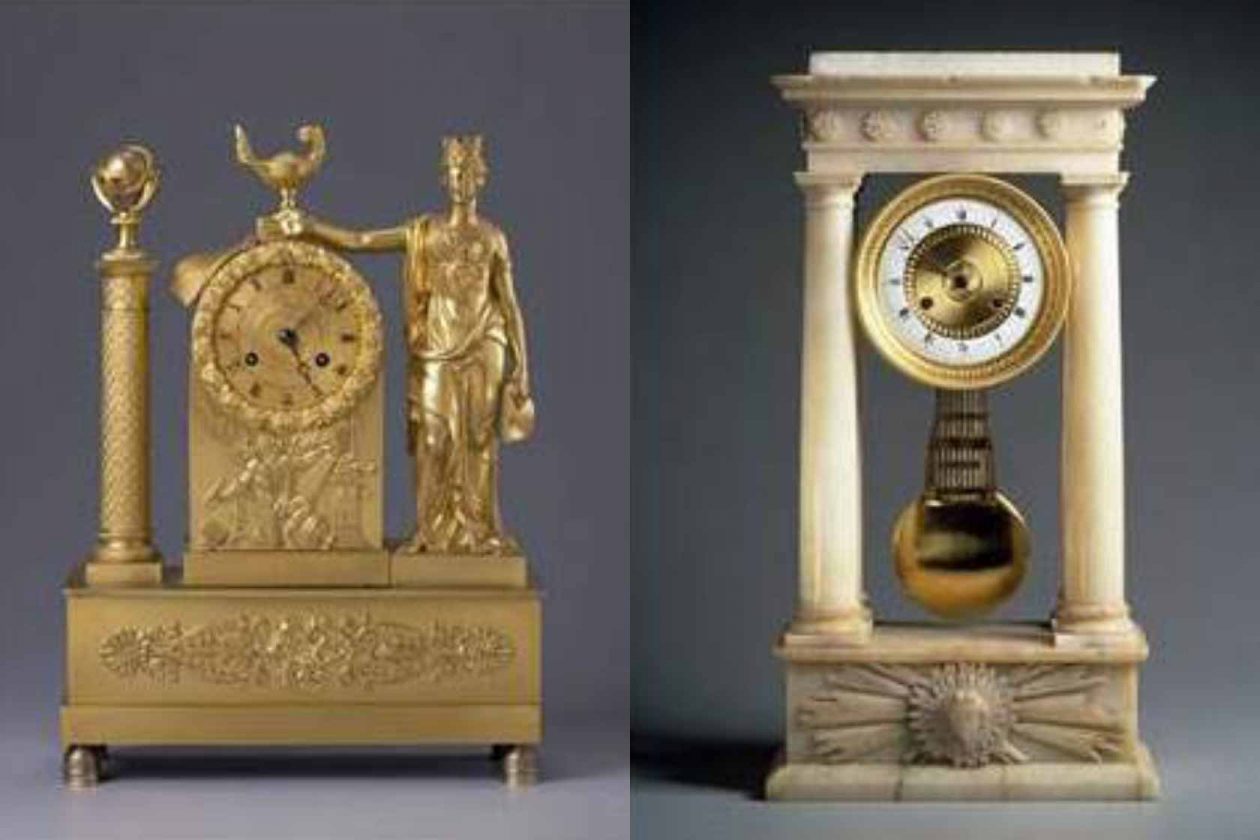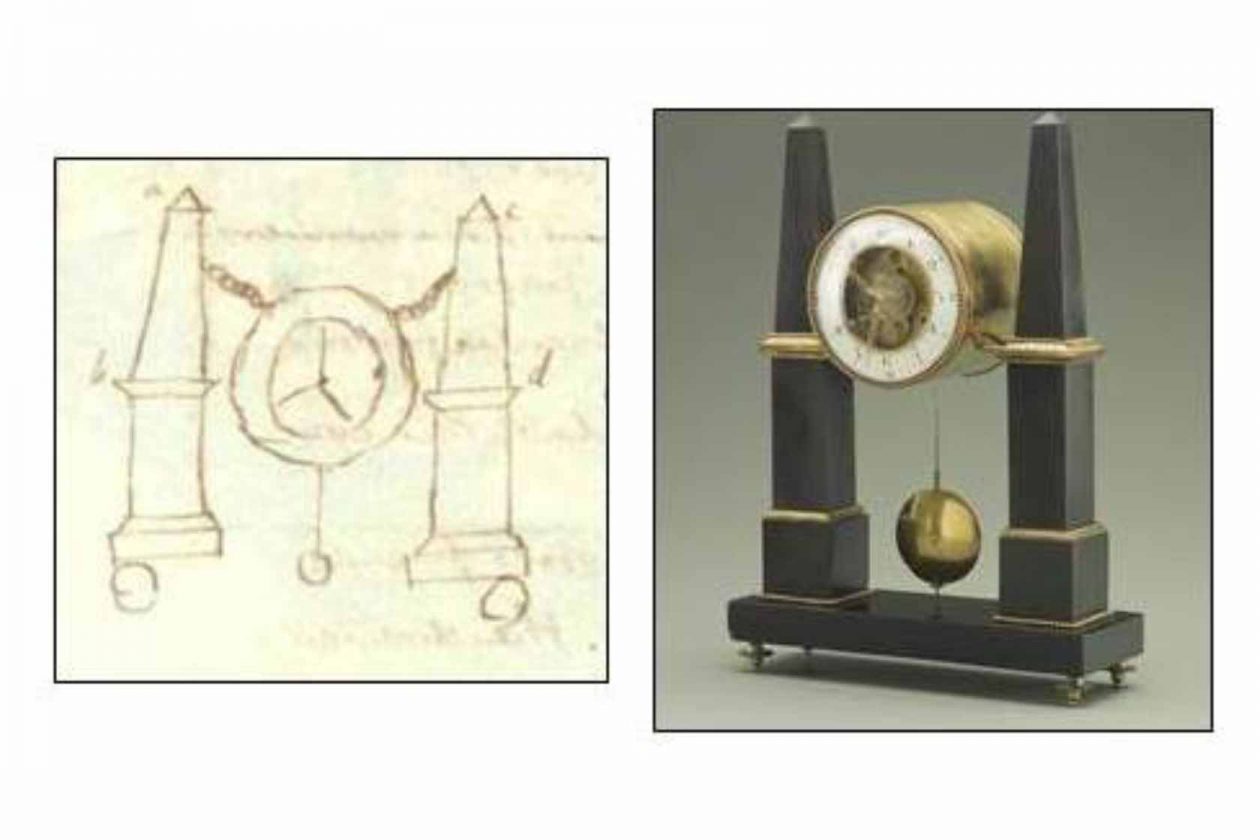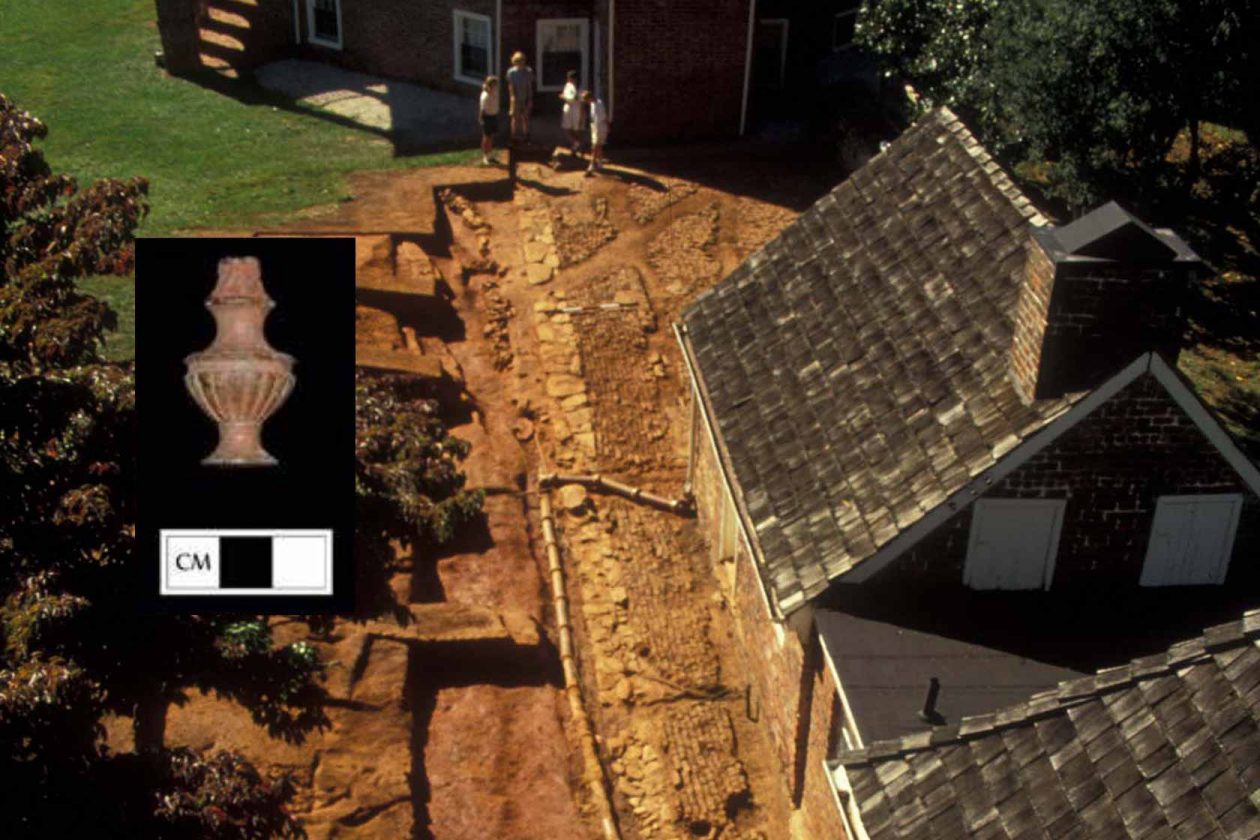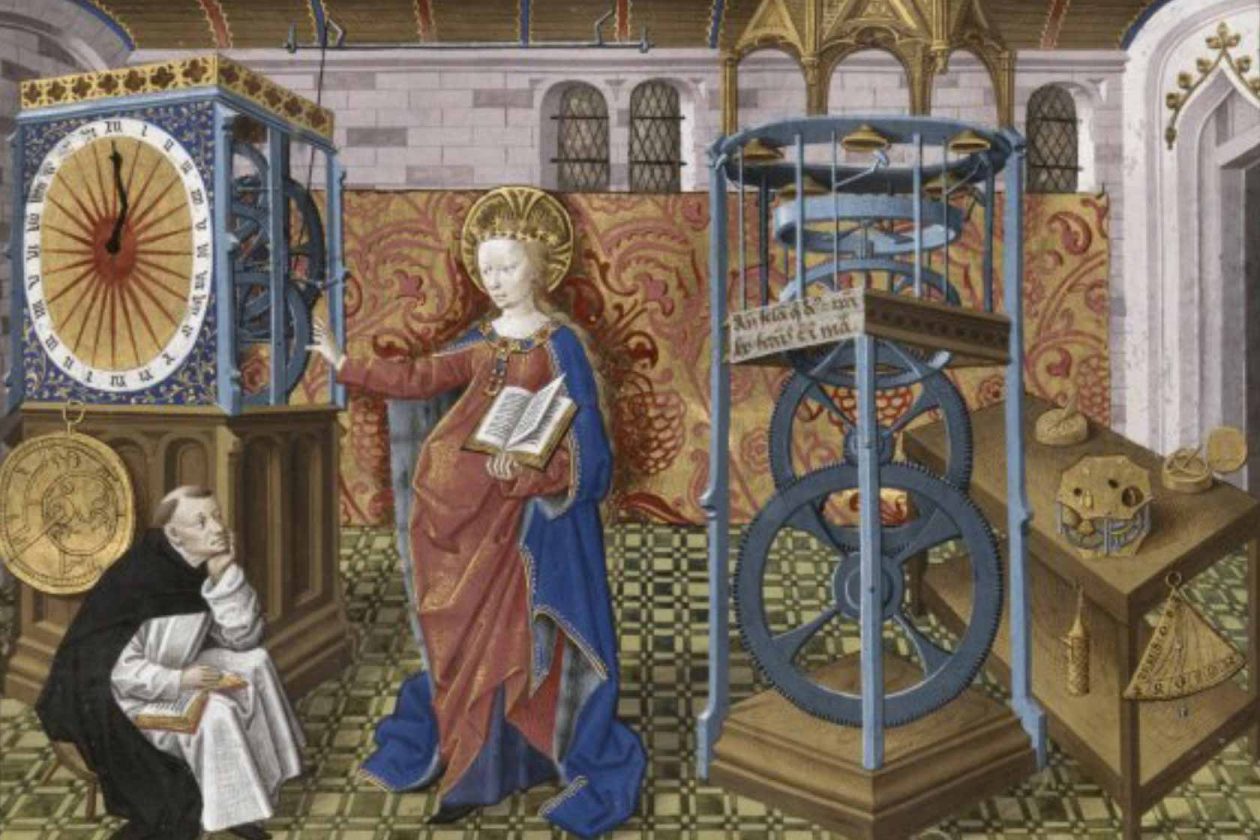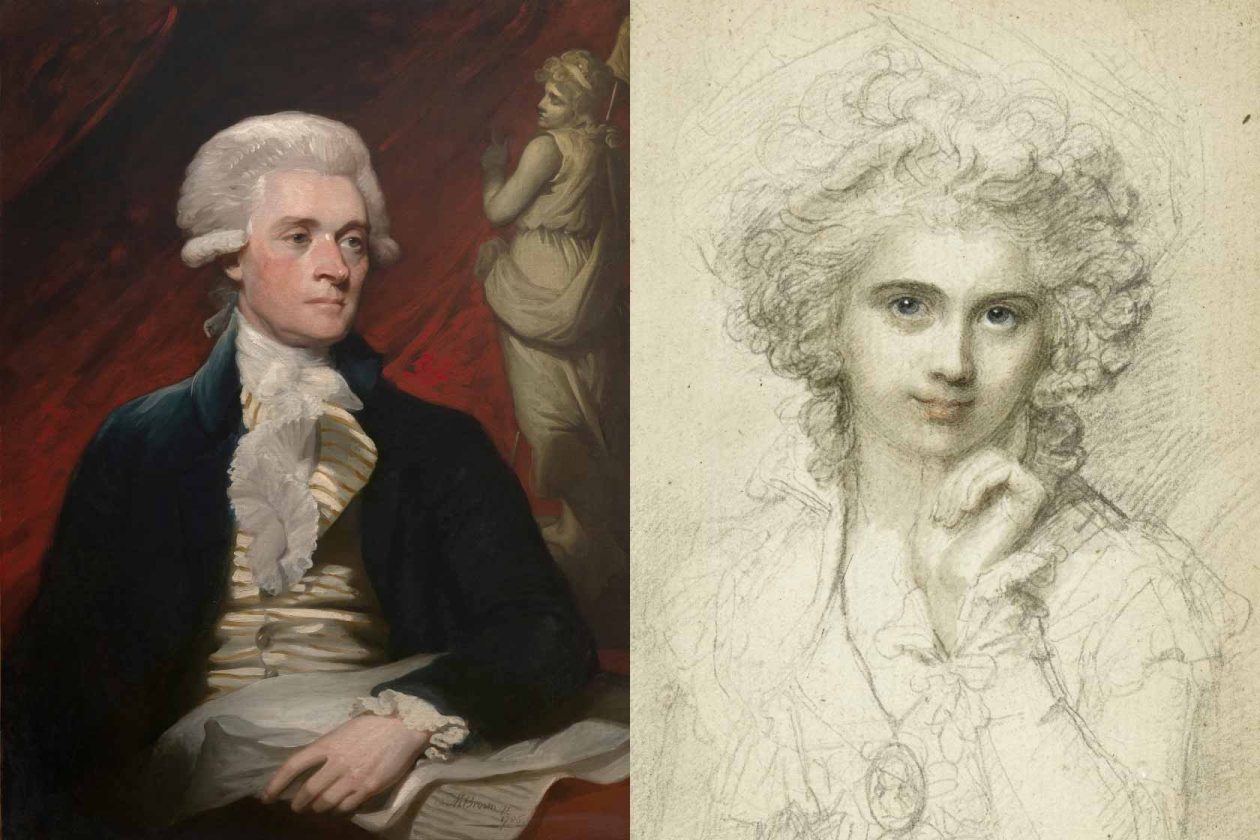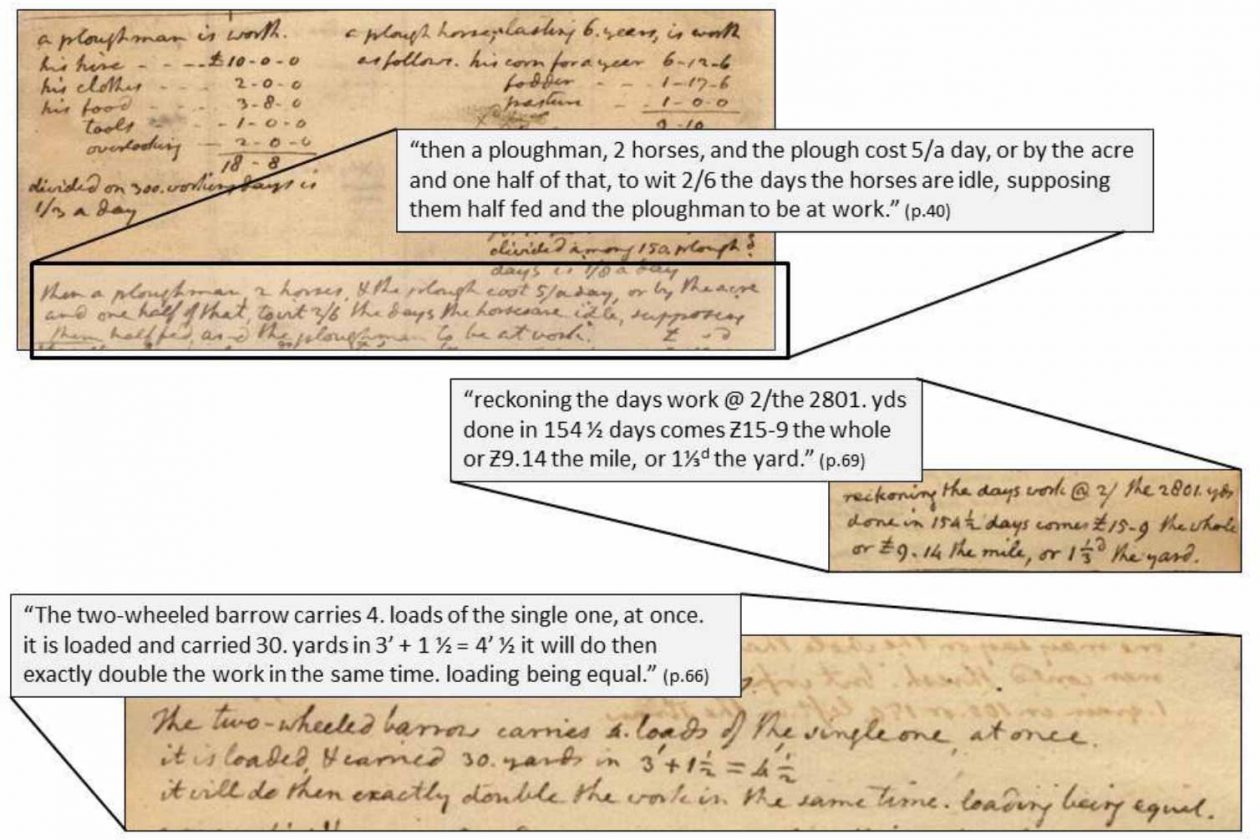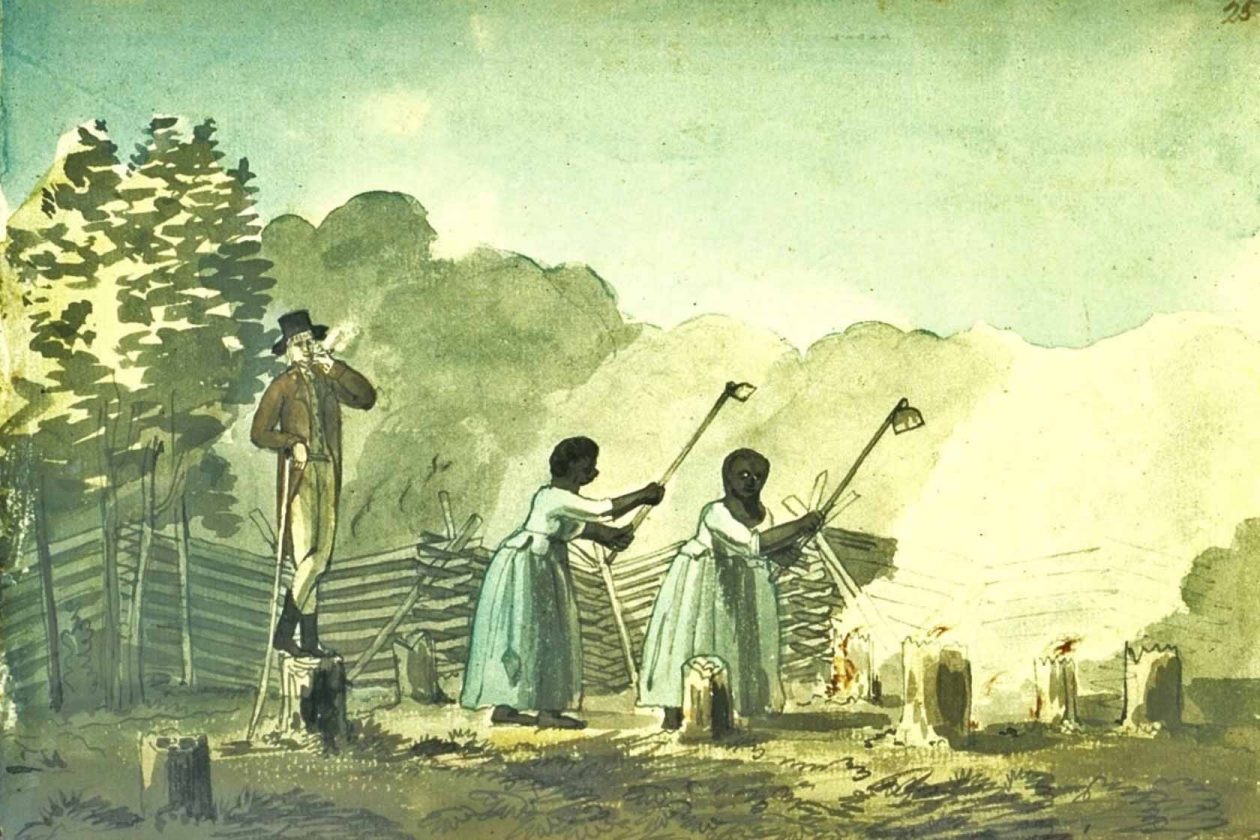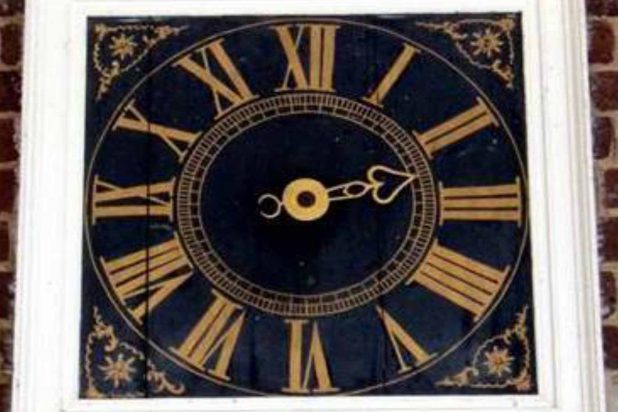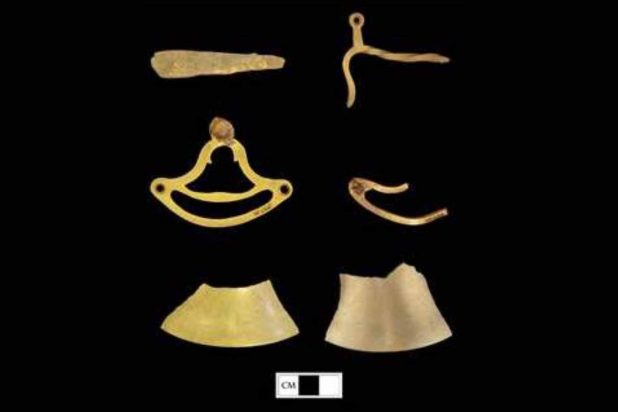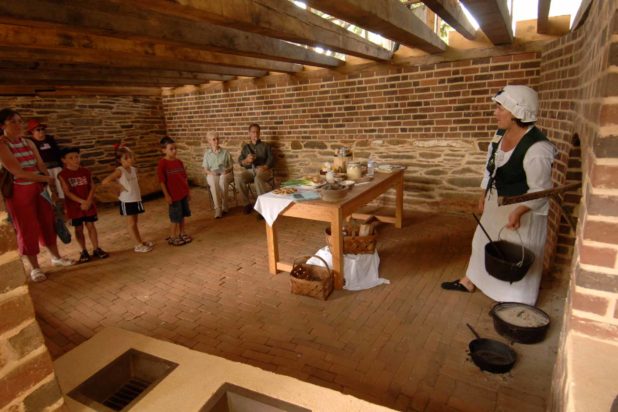Archaeology Blog
Traces of Jefferson’s Time at Poplar Forest
By Karen E. McIlvoy
Thomas Jefferson owned and designed many clocks and watches throughout his life; enough that his home at Monticello contains at least one in nearly every room. There is even an oral tradition that it was his practice to gift each of his children and grandchildren a pocket watch when they reached the age of 12 (Bedini 1964: 163).
Antique clocks, those over 100 years old, are classified according to many diverse criteria, including size, shape, location and date of manufacture, and operation of the timekeeping mechanism. Jefferson is known to have owned timepieces of several origins and styles, many of which are still at Monticello.Tall case clocks, also called long case clocks, are tall, narrow, freestanding floor clocks operated by a weight-driven pendulum held inside a wooden case. The weights suspend down from long cables attached to the movements (Chappell 2001). Their mechanisms would be wound either every 30 hours or 8 days, depending on its construction. Jefferson owned at least two 8-day tall case clocks at Monticello. The Astronomical Case Clock, currently located in Jefferson’s Cabinet, was made by Thomas Voight in 1812. It was ornamented with reeded pilasters and crowned by a scrolled, broken pediment. It has no striking mechanism and operates with a single weight (Stein 1993: 380). The decidedly plainer Tall Case Clock located in the Monticello kitchen bears little decoration other than the freestanding columns supporting its flat-topped hood (Stein 1993: 379).
In contrast to the precisely defined category of tall case clocks, shelf clocks is a broad term that encompasses any type of relatively small house clock traditionally placed on the shelf, or mantel, above the fireplace. Because the actual mechanical workings of these clocks were scaled down, the size and length of the pendulums and weights to operate them were proportionally smaller as well, thus allowing for greater freedom in stylistic expression. Nineteenth-century shelf clocks were often ornately decorated and are therefore classified most often by their decorative shape and design.
Monticello currently displays several shelf clocks belonging to Thomas Jefferson. One gilt brass clock in the French style shows a classical figure with her hand extended toward a globe resting atop a pillar. The clock face is placed between with a winged figure below and an oil lamp above. This clock was made by Louis Moinet in Paris and may be classified as a French Empire clock (Stein 1993: 381). A Pillar Clock resting on the mantel in the Monticello dining room has a brass and painted dial and short, wide pendulum suspended between two marble columns.
Jefferson enjoyed adapting and designing timekeepers as well. He marked the weight path inside the case of his astronomical clock with the days of the week, so that the dropping weight would indicate the day (Stein 1993: 380). Similar labels adorn the wall of the Entrance Hall at Monticello, next to the ropes holding the running weights that operate the Great Clock.
The famous Obelisk Clock was constructed to Jefferson’s specifications to replace a similar one that was stolen from his Paris residence. Parisian clockmaker Louis Chantrot completed the clock in 1791 and it was delivered to Jefferson in Philadelphia on October 22. It was later mounted on a small shelf above the foot of his bed at Monticello (Stein 1993: 374).
Jefferson considered the sundial to be “the cheapest and most accurate measure of time for general use, and would, I suppose, be more common if every one possessed the proper horary lines for his own latitude” (TJ to Charles Clay, August 23, 1811). Thus, while laid up by rheumatism at Poplar Forest in August 1811, Jefferson amused himself by “calculating the hour lines of a horisontal dial for the latitude of this place which I find to be 37°-22ʹ -26ʺ. He included this list of measurements “for every 5. minutes of time…exact to within less than half a second of a degree” with a letter to Charles Clay, suggesting it be made of slate “as being less affected by the sun [and] preferable to wood or metal” (TJ to Charles Clay, August 23, 1811). Five years later, Jefferson designed and built a sundial for Monticello. He included a sketch of the final product with his detailed description in 1816, and the following year observed that it “captivates every body foreign as well as home-bred, as a handsome object & accurate measurer of time” (TJ to Latrobe, June 12, 1817).
Over the past few years, archaeologists at Poplar Forest, Jefferson’s retreat in Bedford County, Virginia, have been reevaluating one of our most significant archaeological collections. Excavations of the Wing of Offices located east of the Main House took place from 1989 to 1991 and produced almost 60,000 artifacts, many of which are associated with the past owners of Poplar Forest and the enslaved community that lived and labored on the plantation. This collection included a single small, uniquely shaped item; a copper alloy foot, urn-shaped with vertical flutes. This object has been tentatively identified as a foot for a shelf-clock due to its size, decorative nature, and relative similarity to known examples at Monticello.
Considering the proliferation of clocks in Jefferson’s life, finding a clock part at his Bedford home is not surprising. But this little artifact begs a large question: what role did time play at Poplar Forest?
In the Middle Ages, when the vast majority of people were engaged in some way with farming, time was a more nebulous entity, divided as needed by the cycles of nature or the religious calendar (Landes 2000: 53). Day versus night, birth versus death, planting versus harvest, time to work, or time to pray; these were the meaningful divisions of life. In general, within this medieval perspective, there was no formal concept of wasted time; rather, all time belonged to God (O’Malley 1990: viii). But the creation and development of mechanical time began to change this concept. By the 17th century, radically improved clocks had changed the way Europeans thought of time itself. Time was more strongly perceived as linear and irretrievable, and redeeming time, or using it properly, became an overriding concern (Sobel 1987: 17- 21). Although a strongly religious perception of time persisted, a more secular understanding of time gained authority until it gradually became the dominant paradigm in the Euro-American world.
By Jefferson’s lifetime, followers of Isaac Newton, called Newtonians, had adapted his idea of a universal and all-encompassing “absolute” time into a philosophy that time had a dual nature; one part absolute reality, which was necessary for science and business; the other part relative, subjective and emotional (Spahn 2011:18). Thomas Jefferson was a well-read man of his era and his library included several volumes of both Newton’s work and its commentary (Gilreath and Wilson 1989). Historians have explored many areas of Jefferson’s life in which he was quite capable of holding dualistic understandings, from his contradicting views on politics to economics to slavery, so it would not have been difficult for him to accept this dual nature of time as well (Spahn 2011: 16).
In his famous love letter to Maria Cosway, he demonstrates this understanding of time through a written conversation between his Head and his Heart (TJ to Cosway, October 12, 1786). The Head scolds the Heart for being bereft at the lady’s loss; reminding it that “Everything in this world is a matter of calculation…” and that the future is not going to wait, so one should rise above the petty concerns of society and contemplate the laws of nature. The Heart counters that it enjoys the “bustle and tumult of society” and prefers to dwell in the past rather than plan for the future. In this letter the Heart’s time moves at different speeds while the Head’s time flows at a constant pace.
Jefferson’s Head seems to have won out for most of his everyday activities. He liked to keep busy. Time was scarce and should not be squandered on trivial matters but always used to its fullest on meaningful or worthwhile pursuits. In letters to his daughter Martha, Jefferson wrote that “The idle are the only wretched.” and encouraged her to “Determine never to be idle. No person will have occasion to complain of the want of time, who never loses any. It is wonderful how much may be done, if we are always doing.” (TJ to Martha Jefferson, May 5, 1787; May 21, 1787).
And he held strong opinions about what she should be doing. When she was still a child, Jefferson outlined a daily schedule for Martha to help her avoid the temptation of wasted time: from 8 to 10: practice music, 10 to 1: dance or draw, 1 to 2: write a letter, and so on (TJ to Martha Jefferson, November 28, 1783). His grandchildren received similar advices over the years (see TJ to Jefferson Randolph, May 14, 1810, TJ to Francis Eppes, May 21, 1816).
So which sense of time was at work on Jefferson’s plantations?
At Poplar Forest, as at Monticello, Jefferson adhered strictly to the logical time of his Head. He was a notorious record keeper and often measured the cost of tasks by their allotted time. Many examples of this tendency are to be found in Jefferson’s Farm Book. On one page, he calculated the worth of one ploughman and one plough horse over the course of a 300-day working year (TJ Farm Book, p.40). On another, he recorded the work done by five men making a path at Monticello to have equated to 1 ⅓ dollars per yard (TJ Farm Book, p.69). One of the best examples, though, is when Jefferson was trying to explain why he chose to have workers use a two-wheeled barrow instead of a single-wheeled barrow because it could be loaded in 3 minutes and carried 30 yards in an additional 1 ½ minutes, thus “it will do then exactly double the work in the same time” (TJ Farm Book, p.66).
Jefferson’s calculations and measurements of time give us invaluable insight into how his plantations were run on a daily basis. Poplar Forest was a 5,000-acre plantation in Bedford County, inherited by Jefferson from his father-in-law in 1773 (Chambers 1993:4). From that time through 1800, he made only two visits there, placing the day-to-day management of the property in the hands of overseers and stewards (Marmon 1991:19-21). By the time that Jefferson began building his retreat home there in 1806, Poplar Forest had become one of his more profitable holdings and was home to almost seventy enslaved people (TJ Farm Book, p.60). Stewards and overseers directed the workers to meet expectations set by Jefferson and the letters between these men do imply that his instructions for Poplar Forest paid close attention to measuring the use and passage of time. For example, in one letter to his Poplar Forest overseer, Joel Yancy, Jefferson expressed his concern that the “overseers do not permit the women to devote as much time as is necessary to the care of their children”, thus causing a morbid loss of profit (TJ to Yancy, January 17, 1819).
Almost 40% of the slaves imported to Virginia in the 18th century originated in the Bight of Biafra, where many cultures shared a basic attitude toward time as having distinct periods, but no calibration thereof; with no regular hours or minutes, time varied as needed (Sobel 1987: 26, Gomez 1998, Mullin 1992). This attitude, passed on to their descendants that crossed the Atlantic, would have conflicted with the almost factory-like efficiency Jefferson envisioned for his plantations. In part because of this contradiction in the understanding and use of time, Jefferson, like many contemporary slaveholders, was convinced of the innate laziness of his enslaved workers (Smith 1997, Jefferson 1785). Since Jefferson wrote in his book Notes on the State of Virginia (1785: 148-154) that he believed a slave’s natural tendency was toward indolence, he felt slaves needed to be regulated by someone with an appreciation for the value of time. As a result, he and his managers forced enslaved workers to obey their schedule through the constant repetition of regulated time through sound.
When Jefferson installed his Great Clock at Monticello, he specifically requested a Chinese gong be put in so that it could “serve as the bell…which might be heard all over my farm” (TJ to Henry Remsen, Jr, November 13, 1792). Jefferson also had servant bells installed in both Monticello and Poplar Forest so that he could call for servants when he wished for them. In a sense, through these acts, Jefferson was aurally reminding all who could hear, that their time belonged to him. Bells and horns were used throughout the plantation South to signal work hours and schedules for both field and house slaves and interviews with former slaves in the 1930’s included many reminiscences of the impact of these sounds. By establishing strict temporal regulations on working hours, meal breaks, curfews, and even so-called ‘free time’, he could reinforce his dominance over his enslaved people without necessarily having to resort to harsher means of motivation (Smith 1997: 137).
In a 1795 entry to his Farm Book, Jefferson described arrangements for the next harvest, specifying that “great George, with tools and a grindstone mounted in the single mule cart, should be constantly employed in mending cradles and grinding scythes. The same cart would carry about the liquor, moving from tree to tree as the work advanced…in this way the whole machine would move in exact equilibrio…” (TJ Farm Book, p.46). By organizing his team and tightly controlling their schedule, Jefferson was imposing his own obedience to time on his enslaved workforce.
Jefferson tried to achieve a similar clockwork-like quality in another aspect of plantation labor: his dinner. Jefferson moved the kitchen at Monticello to its current location in 1809 and built in features that made it state-of-the-art and better equipped to prepare his preferred French-style cuisine (Sarafin 2005: 21). Along with an eight-grate stew stove, counter-like work surfaces, specialized cookware, a staging area for plating, and a clockwork spit-jack mounted on the fireplace wall, Jefferson had a longcase clock placed in the corner of the kitchen (Sarafin 2005: 24-25). Jefferson himself wound this clock every Sunday, an act that not only ensured he would receive his meals cooked properly and served on time, but also a performance that reinforced his control over the kitchen staff (Jefferson 1847). When visiting Poplar Forest, Jefferson expected the same level of dining service. The kitchen, located in the Wing of Offices at Poplar Forest and run by a literate enslaved cook named Hannah, though smaller than Monticello’s, was also built with a multi-grate stew stove, a set kettle, a domed oven, and other specialized equipment (Kelso et.al. 1991: 24, 30-31). It is not unreasonable to assume it too contained a clock; possibly even the one attached to our small brass foot.
Today, we are accustomed to minding the clock. We are so used to arranging our days by the hour that most of us can’t fathom any alternative. But the temporal landscape of early America was still undecided. One study of late 18th century inventories in Virginia estimated that over 90% of the general population never had mechanical timepieces. When Jefferson built and visited his retreat at Poplar Forest, clocks were still a relatively expensive commodity in America. By 1800, a tall case clock, the most common style in the country, could cost up to $80 for a brass movement, painted dials, and a case to house them. Almost all portable watches were still imported and an accurate gold watch could cost $90 (Smithsonian n.d.). By contrast, the average daily wage for a farmer or agricultural worker in the same period was only $0.40 per day (U.S. Dept. of Commerce).
Jefferson’s expenditure on clocks was not insignificant. The measurement and proper consumption of time was an omnipresent concern in his life that bled into the very framework and function of his plantations.
ReferenceS
Bedini, Silvio. 1964 Thomas Jefferson, Clock Designer. Proceedings of the American Philosophical Society, 108(3): 163-180.
Chambers, S. Allen. 1993 Poplar Forest and Thomas Jefferson. The Corporation for Jefferson’s Poplar Forest, Forest, VA.
Chappell, Jessica. 2001 The Long Case Clock: Engineering Behind a Grandfather Clock. Illumin Magazine Vol 1, Issue 4. Online journal hosted by University of Southern California. http://illumin.usc.edu/184/the-long-case-clock-engineering-behind-a-grandfather-clock/
Frank H. McClung Museum. 1981 The Great American Clock: An Exhibition of American Clocks from c.1800 to c.1935. College of Liberal Arts, Univeristy of Tennessee, Knoxville. November 2, 1981-February 26, 1982.
Gilreath, James and Douglas L. Wilson. 1989 Thomas Jefferson’s Library: A Catalog with the Entries in His Own Order. Library of Congress, Washington DC.
Gomez, Michael A. 1998 Exchanging Our Country Marks: The Transformation of African Identities in the Colonial and Antebellum South. University of North Carolina Press, Chapel Hill, NC.
Jefferson, Isaac Granger. 1847 Memoirs of a Monticello Slave, as dictated to Charles Campbell. In Jefferson at Monticello, ed. by James A. Bear, Jr. University Press of Virginia, Charlottesville, Virginia.
Jefferson, Thomas. 1785 Notes on the State of Virginia. Prichard and Hall, Philadelphia, Pennsylvania.
Kelso, William M., M. Drake Patten, and Michael A. Strutt. 1991 Poplar Forest Archaeology Research Report for NEH Grant 1990-1991. Report on file at Thomas Jefferson’s Poplar Forest, Forest, Virginia.
Marmon, Lee. 1991 Poplar Forest Research Report, Revised Edition. Manuscript on file, Thomas Jefferson Foundation, Charlottesville, Virginia.
Mullin, Michael. 1992 Africa in America: Slave Acculturation and Resistance in the American South and the British Caribbean, 1736-1831. University of Illinois Press, Champaign, Illinois.
O’Malley, Michael. 1990 Keeping Watch: A History of American Time. Viking Penguin, New York, New York.
Sarafin, Justin A. 2005 Like Clockwork: French Influence in Monticello’s Kitchen. In Dining at Monticello: In Good Taste and Abundance. Edited by Damon Lee Fowler. Thomas Jefferson Foundation, Inc. Univeristy of North Carolina Press, Chapel Hill, North Carolina.
Smith, Mark M. 1997 Mastered by the Clock: Time, Slavery, and Freedom in the American South. The University of North Carolina Press, Chapel Hill, North Carolina.
Smithsonian National Museum of American History. n.d. On Time: How America Has Learned to Live by the Clock. Online Exhibit, accessed March 2017. http://americanhistory.si.edu/ontime/
Sobel, Mechal. 1987 The World They Made Together: Black and White Values in Eighteenth-Century Virginia. Princeton University Press, Princeton, New Jersey.
Spahn, Hannah. 2011 Thomas Jefferson, Time, and History. University of Virginia Press, Charlottesville, Virginia.
Stein, Susan R. 1993 The Worlds of Thomas Jefferson at Monticello. Harry N. Abrams, Inc. Publishers in association with the Thomas Jefferson Memorial Foundation, Inc.
U.S. Dept. of Commerce. 1975 Historical statistics of the United States, colonial times to 1970. U.S. Dept. of Commerce, Bureau of the Census. Washington D.C.
